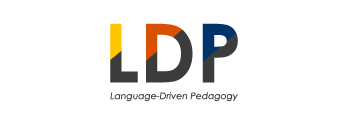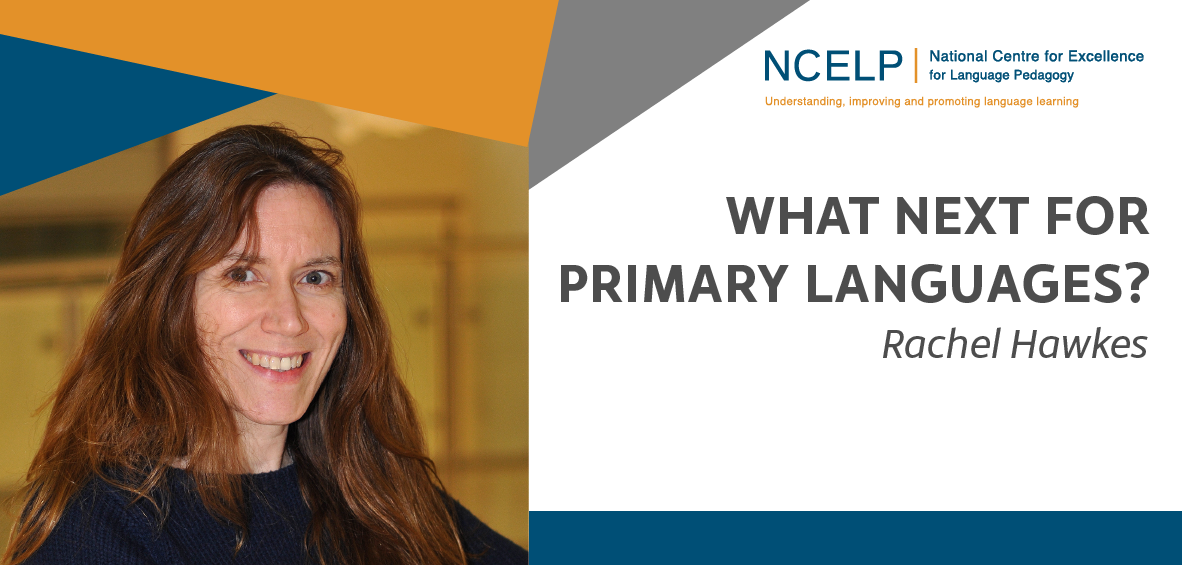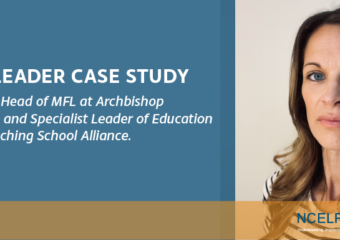Rachel Hawkes, Co-Director of NCELP and Director of International Education and Research at The CAM Academy Trust discusses what the future holds for primary languages
In my trust (The Cam Academy Trust), we aspire to teach our KS2 children a new language to generate a fascination for words and how language works, a wider curiosity about the people and cultures of countries where that language is spoken, and the foundational knowledge to support confident communication. We aim to teach in line with the National Curriculum and align with findings from recent reports, including the RiPL White Paper and Ofsted’s Curriculum Research Review for Languages.
Current policy requires that KS2 language teaching ‘should focus on enabling pupils to make substantial progress in one language.’ Pupils should be able to ‘understand and communicate […],using their knowledge of phonology, grammatical structures and vocabulary’ (DfE, 2013, p.2). Since the introduction of compulsory language teaching at KS2 there has been some progress on this nationally. 93% of primary school respondents to the Language Trends Survey 2022 report that they plan for progress in one language and allocate weekly curriculum time to language teaching. However, the vast majority of responding primary schools (90% at Y3 and 86% at Y6) still teach less than the RiPL Research in Primary Languages) recommended a minimum of one hour per week (Holmes & Myles, 2019).
The gap between policy and practice persists and at national level primary language teaching is still beset by inconsistency of provision and inequality of opportunity. It is easy to list the reasons, which include insufficient time, limited cross-phase planning, a deficit of teacher subject specialist knowledge, a lack of appropriate CPD and, perhaps most significantly of all, a lack of curriculum definition. Previous interventions to provide solutions have seen pockets of success at a local level, but we need to do something more fundamental and far-reaching to level the playing field for all learners.
What?
Enter curriculum. Enter the new GCSE. Enter a defined word list for the first time ever, along with a much more clearly defined language content (grammar, phonics)! This giant step change at KS4 is a quantum leap for KS2 and classroom-based language learning in England.
For the first time we have the means to join up the learning journey from Y3 to Y11 and achieve the ‘agreement with regard to the core content of the curriculum for each key stage in relation to grammar, vocabulary, pronunciation, phonics, knowledge about language, and intercultural understanding’ (p.5, Holmes & Myles, 2019) required to support effective teaching and learning cross-phase.
How?
In our trust, we achieve cohesive language learning cross-phase via the curriculum. We are informed but not constrained by the new GCSE word list. We take what we know (experientially as teachers and from research (Marsden & Hawkes, 2023)) about the number of meaningful encounters that our pupils need with words for them to become securely known. Words are introduced and practised, then revisited after three weeks and again nine weeks later. They recur incidentally several times more across the four years, and are systematically sampled in assessments at the end
of every term, in the same way as NCELP KS3 resources.
How many words?
We take our cue from NCELP’s evidence-informed work to set out reasonable expectations for the number of words that can be taught, practised and revisited with sufficient frequency within our time-limited curriculum, and settle on an average of four words per hour/week. Over four years this is around 512 words, which (coincidentally?) is close to the commonly estimated CEFR A1 vocabulary size 1 .
Which words?
Word selection is informed by frequency but also by the basic grammar set out in the National Curriculum. Concrete nouns (e.g., classroom items) and core sets of language (numbers, days, months) are included to support the learning of essential grammar features, such as articles and plural forms. Around 80% of our KS2 words come from the most common 2000 words 2 , but equally importantly around 90% of our KS2 words overlap with a new GCSE wordlist 3 (which will actually be used by Eduqas for their new GCSE exams). This means that almost all the words taught at KS2 will also be needed for KS3 and KS4. We use curriculum continuity from Y3 to Y11 to give all our pupils the maximum time to develop the knowledge they need to be confident communicators.
Culture, creativity and communication
We place great emphasis on how the aims of the National Curriculum can be operationalised through a language-led, knowledge-rich and practice-based curriculum. The three language-knowledge strands: phonics, vocabulary and grammar underpin the development of confident communication, cultural understanding and creative use of language. Highly effective, carefully planned activities for teaching and practising language knowledge (phonics, vocabulary, grammar) in different modes (receptive/productive) and modalities (aural/written) are embedded in a variety of rich cultural and narrative contexts. The claim we make with this SOW is that we can have it all!
Leveling the playing field
We are excited about this KS2 curriculum. We know it is meticulously planned and exemplifies excellent progression. To provide solutions to the other challenges we face in primary languages, our SOW and resources set out a 30-minute lesson and a supplementary follow up sequence of five short five-minute activities, designed to be used during the week. Lesson by lesson resources are FREE, fully adaptable for teachers to work with in their own contexts, and have two versions. One is fully audio’d by a native speaker teacher and the other version has audio for the listening tasks only. We also provide CPD targeted particularly at primary language practitioners who are non-language specialist teachers or who lack confidence in the language they are teaching.
“Ofsted have said that they have very specific ideas of what good progression looks like but we can’t find a scheme of work that matches it. That would be VERY useful!”
“Once a week is not good enough as the children forget most of what they have learnt from one week to the next. “
“There needs to be more money, both for CPD and resources. I end up spending a fortune of my own money on resources, and online subscriptions, as school doesn’t have the budget.”
“There is clearly a need for CPD support that is KS2 appropriate for non-language speakers. This would need to be free or subsidised.”
Language Trends, 2022, p.12
If you are interested to learn more, download the SOW and resources for your language and/or access CPD opportunities, please follow these links.
The French KS2 resources are a collaboration between Dr Marie-Odile Guillou and me. The French phonics elements come with video inserts for practising mouth shape as well as sound imitation. The lessons draw on the NCELP French team’s (led by Natalie Finlayson and Cath Salkeld) KS3 SOW and resources, which are in turn informed by the research work of Professor Emma Marsden and colleagues, including Dr Rowena Kasprowicz.
Spanish SOW and resources are written by Paula Vázquez-Valero, Spanish teacher and SLE at Comberton Village College and me. The lessons owe much to the NCELP team’s KS3 SOW and resources (led for Spanish by Nicholas Avery and Amanda Izquierdo), which are in turn informed by the research work of Professor Emma Marsden and colleagues, including Rowena Kasprowicz.
The German KS2 SOW and resources are being developed in collaboration with PiPL (Progression in Primary Languages), a longitudinal study of language learning in primary school (French, German and Spanish), led by Dr Rowena Kasprowicz at the University of Reading. They are being created by Dr Heike Krüsemann, Helen Gass and me. Our KS2 SOW and resources in all three languages are being used in this project.
Phonics, vocabulary, grammar | Culture, creativity, communication – Let’s have it all at KS2! Sign up for this FREE Primary Language Learning webinar (Thursday 6 October, 4-5pm) with Dr Rachel Hawkes, hosted by Languagenut.
The Primary Bee
Schools interested in raising the profile of language learning in their schools may want to consider taking part in the Foreign Languages Primary Bee. The aim of the Primary Bee is for pupils in Years 5 & 6 who have started learning a foreign language ab initio in KS2 to practise and improve their vocabulary, pronunciation and memory skills in the target language (French, Spanish and German). The three-stage competition has 40 words per stage. The words overlap with our KS2 curriculum and the new GCSE wordlist.
1 Note that the Common European Framework of Reference for Languages (CEFR) specifies neither a vocabulary list nor a vocabulary size for each of its levels.
2 Commonly used word frequency resources include: ‘Davies, M., & Davies, K. (2018). A frequency dictionary of Spanish: Core vocabulary for learners (2nd ed.). London: Routledge’; ‘Lonsdale, D. & Le Bras. Y. (2009). A frequency dictionary of French: Core vocabulary for learners. London: Routledge’; and ‘Tschirner, E. & Möhring, J. (2019). A frequency dictionary of German: Core vocabulary for learners (2nd ed.). London: Routledge’. More information on the suitability of these word lists can be found here. 3 Eduqas is using the NCELP GCSE word lists to create their new GCSEs in French, German and Spanish
References
Collen, I. (2022) Language Trends 2021/22: Language Teaching in Primary and Secondary Schools in England Survey Report. British Council. [Online]Available online at: language_trends_report_2022.pdf (britishcouncil.org)
Department for Education (DfE). (2013). Languages programmes of study: key stage 2. Available online at: National curriculum in England: languages programmes of study – GOV.UK (www.gov.uk)
Holmes, B. and Myles, F. (2019). White Paper: Primary Languages Policy in England – The Way Forward. RiPL. Available online at: www.ripl.uk/policy/
Marsden, E. & Hawkes, R. (2023). Situating practice in curriculum design in school foreign language education. In Y. Suzuki, & T. Nakata (Eds.) Practice and Automatization in Second Language Research: Theory, Methods, and Pedagogical Implications. Chapter 4. Routledge.
Ofsted (2021) Curriculum research review for languages. 7 June, 2021. [Online]




